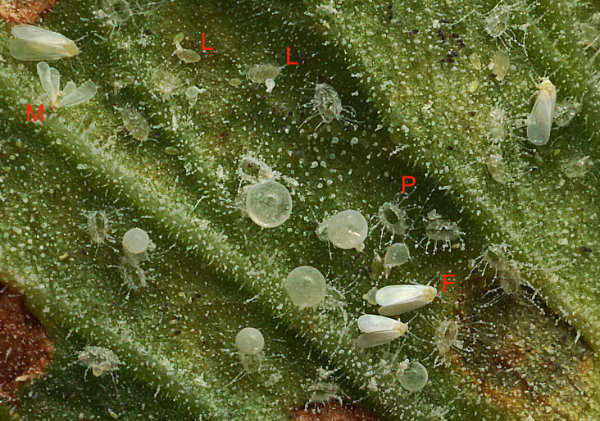Trialeurodes vaporariorum

A geranium plant that I supposedly take care of has a serious infestation with whiteflies. Before dousing the plant with insecticidal soap (a procedure I am supposed to follow every week for a while), I snapped the preceding picture. There is a lot of there there, so I asked Mark Sturtevant exactly what I am looking at. His response:
The spiky things are a weird part of the life cycle of whiteflies. Although they are in the order Hemiptera, which are 'supposed' to have incomplete metamorphosis (passing thru nymphal stages before molting into adults), whiteflies are hemipterans that essentially have a larval stage and pupal stage of holometabolous insects.
You can see quite a bit going on here in this one picture. I have re-attached your picture with some annotations.
I don't know if there are eggs in view. The tiny white specks look more like glandular secretions from the leaf. But there are a few larvae along the top border of the picture, and I have marked some with an L. You see the pupal stage already (one is marked with a P), but technically these are puparia. When a larva becomes a pupa, the larva usually sheds its cuticle to show the pupa underneath, with its own cuticle. But in whiteflies (and in some other insects like flies and fleas), the larva does not shed its cuticle. Rather, it puffs it out, hardens it, and the pupal stage stays locked inside the larval cuticle. That outer larval shell is called the puparium. Then there are the adults. The large adults are females, and I have marked one with an F. Males are smaller and much more active. Winged males fly and seek out females. I think the one labelled M is a male.
Indeed, the day was warm, and there were lots of males on the window trying to get out.
I asked Dr. Sturtevant about the transparent spheres that clutter the frame:
I don't know what the big spheres are, but it could be like aphids (whiteflies are related to them) which periodically secrete a drop of honeydew. This is excess water from plant sap, and aphids secrete that to concentrate the nutrients. Since whiteflies are always secreting a waxy bloom, a thin wax coating on their honeydew droplets would hold them together. That's a hypothesis, but I don't really know.
